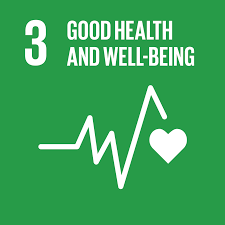Breaking the Stigma surrounding Mental Health
- Malika

- Jul 14, 2020
- 3 min read
This article is focused on these Sustainable Development Goals (click to learn more):
SDG 3 strives to ensure healthy lives and promote well-being for those of all ages. Supplementary to this goal is target 3.4 which aims to reduce premature mortality from non-communicable diseases through prevention and treatment, as well as the promotion of mental health and well-being. The UN further recognizes that the right to the highest attainable standard of physical and mental well-being is a human right. Yet, to this day, there is a strong stigma attached to issues relating to mental illnesses and emotional well-being. Mental illness is treatable and suicide is preventable. Even so, many suffer in silence due to the inherent stigma surrounding this issue. The Mental Health Foundation reports that this thought process leads to discrimination against those with mental health issues, which in turn worsens their health and recovery process.
Research shows that 50% of mental health conditions start by the age of 14 but most cases are either undetected or untreated. Furthermore, 2/3 students with anxiety or depression don’t seek treatment, impairing both physical and mental health, and limiting opportunities to lead fulfilling lives as adults. Nearly 9/10 people with mental health issues say that this stigma has had a negative effect on their lives. Maggie Warrell states, “If people felt as comfortable talking about their PTSD, bipolar or anxiety as they did talking about their eczema or tennis elbow, it would markedly reduce the suffering of those with mental illness and the ability of those around them to support them” (2018). Hence, it is blatantly obvious that in order for anyone to be able to live a life with the basic right of well-being obtained and achieved, mental health issues need to be de-stigmatized and addressed openly.

So how can we contribute and ensure that this goal is reached? Depending on where you are in terms of your mental health, there are varying ways to go about assisting those in need.
For those facing any form of a mental health issue:
Speak up. Tell someone close to you (a friend, school counselor, or trusted adult) how you are feeling a minimum of once every 3 days. Keep in regular contact with them.
Engage in self-care at least once a day. This can range from taking a long walk to bullet journaling. Here is a longer list.
Write a list of things that can validate or uplift you when you are feeling down. Good places to start may be ‘Why you are strong’, ‘Why you are wanted’ and ‘How much you are loved’
Remember that some stigmas are meant to be broken. If you are afraid to speak up because you’re afraid of being judged or looked at differently, know that there are others around you who are probably in a similar situation. Nobody has the right to judge you for anything.
Here are a few other support sources such as helplines that may aid you.
It is inspiring to see how people break barriers and talk about their own issues freely. If you ever need some inspiration, you can find it here!
For everyone else:
Educate yourself. Learn about the symptoms of common mental health problems and what you should do if someone approaches you asking for comfort.
Symptoms. This will help you identify those around you who may be in need of help.
Offering help & next steps to take. This will guide you through ways to help someone who has looked to you for comfort.
Common mental health issues. Going through this will help you be more confident when talking and listening.
Spark conversations on these issues. This will help you learn to address these issues publicly as well as help those around you break down some of that stigma.
Furthermore, learn to use the right language and terminology with these issues.
Learn to be introspective and empathetic; understand that it is okay for someone to not be okay. This will help you see them as a fellow human being as well, not a ticking time bomb.
Understand that hurt people, hurt people. Those who are troubled will lash out sometimes. And that’s okay. Learn to stick with them and deal with it the right way.
Look through a few resources to help challenge mental health stigma and discrimination in the community around you.
We are the key to the future. This is just the first step to a stigma-free society and one day, we will reach there. Remember, change starts with you.
Get Involved!
A few useful NGOs:
Bibliography
SDGs .:. Sustainable Development Knowledge Platform. sustainabledevelopment.un.org/topics/sustainabledevelopmentgoals.
Human Rights. www.un.org/en/sections/issues-depth/human-rights/.
“Stigma and Discrimination.” Mental Health Foundation, 10 Feb. 2020, www.mentalhealth.org.uk/a-to-z/s/stigma-and-discrimination.
“Adolescent Mental Health.” World Health Organization, World Health Organization, 23 Oct. 2019, www.who.int/news-room/fact-sheets/detail/adolescent-mental-health.
“Statistics.” Active Minds, www.activeminds.org/about-mental-health/statistics/.
Warrell, Margie. “The Rise And Rise Of Suicide: We Must Remove The Stigma Of Mental Illness.” Forbes, Forbes Magazine, 11 June 2018,
www.forbes.com/sites/margiewarrell/2018/06/09/the-rise-and-rise-of-suicide-we-must-remove-the-stigma-of-mental-illness/.







Comments